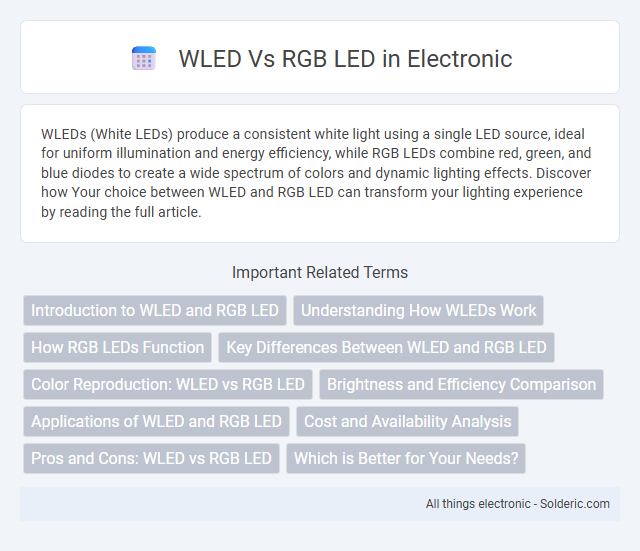WLEDs (White LEDs) produce a consistent white light using a single LED source, ideal for uniform illumination and energy efficiency, while RGB LEDs combine red, green, and blue diodes to create a wide spectrum of colors and dynamic lighting effects. Discover how Your choice between WLED and RGB LED can transform your lighting experience by reading the full article.
Comparison Table
| Feature | WLED | RGB LED |
|---|---|---|
| Definition | White LED emitting single color light | LED with Red, Green, and Blue chips for full color range |
| Color Output | Single white color (cool, warm, or neutral) | Multiple colors via mixing RGB channels |
| Use Cases | General lighting, backlighting, indicators | Decorative lighting, displays, mood lighting |
| Control | Simple on/off or dimming | Complex color control with PWM or drivers |
| Cost | Lower cost | Higher cost due to complexity |
| Power Consumption | Typically lower power for white light | Variable power depending on colors and brightness |
| Applications | Residential, commercial lighting | Signage, entertainment, architectural lighting |
Introduction to WLED and RGB LED
WLED (White Light Emitting Diode) produces a consistent and energy-efficient white light source widely used for general lighting applications. RGB LED (Red, Green, Blue Light Emitting Diode) combines three color emitters to create a broad spectrum of customizable colors for decorative and display purposes. Your choice between WLED and RGB LED depends on whether you need pure white illumination or dynamic color mixing for visual effects.
Understanding How WLEDs Work
WLEDs (White Light Emitting Diodes) operate by combining a blue LED chip with a phosphor coating that converts blue light into white light through a process called photoluminescence. This method ensures efficient, uniform white light generation ideal for lighting and display applications. Unlike RGB LEDs, which blend red, green, and blue light to create various colors, WLEDs specifically optimize white light output for clarity and energy efficiency.
How RGB LEDs Function
RGB LEDs function by combining red, green, and blue light-emitting diodes within a single package to create a wide spectrum of colors through varying intensities of each primary color. The precise control of these three diodes allows for seamless color blending and dynamic lighting effects, which is essential for creating customized lighting atmospheres. When integrated with WLED software, you gain enhanced control over the color output, patterns, and transitions of your RGB LED setups.
Key Differences Between WLED and RGB LED
WLEDs (White LEDs) emit a single, consistent white light using a blue LED with a phosphor coating, while RGB LEDs combine red, green, and blue diodes to create a wide spectrum of colors through varying intensity levels. WLEDs are energy-efficient and ideal for general illumination, whereas RGB LEDs offer advanced color customization for decorative and display applications. The control complexity is higher in RGB LEDs due to the need for precise color mixing, unlike the straightforward operation of WLEDs.
Color Reproduction: WLED vs RGB LED
WLED (White LED) typically uses a blue LED with a phosphor coating to produce white light, offering limited color reproduction primarily in shades of white. RGB LEDs consist of separate red, green, and blue diodes that mix colors to achieve a wide spectrum of hues and vibrant customization options. For applications demanding dynamic and precise color control, RGB LEDs provide superior color reproduction compared to WLEDs.
Brightness and Efficiency Comparison
WLEDs (White LEDs) generally provide higher brightness and better energy efficiency compared to RGB LEDs due to their optimized phosphor conversion of blue light to white light, resulting in greater lumen output per watt. RGB LEDs combine red, green, and blue diodes to create white light, but their overall efficiency tends to be lower as color mixing reduces brightness and increases power consumption. In applications demanding intense illumination and energy savings, WLEDs outperform RGB LEDs by offering up to 30% more luminous efficacy under equivalent power conditions.
Applications of WLED and RGB LED
WLEDs are primarily used in backlighting for LCD displays, general illumination, and automotive lighting due to their high efficiency and excellent color rendering. RGB LEDs find applications in dynamic color displays, decorative lighting, and mood lighting, where customizable and vibrant color output is essential. Both types are integral to modern lighting systems but serve distinct purposes based on their color output capabilities and design flexibility.
Cost and Availability Analysis
WLEDs, or white LEDs, typically offer lower upfront costs and wider availability due to their use in standard lighting applications, making them an economically efficient choice for general illumination. RGB LEDs, which combine red, green, and blue emitters to create a broad spectrum of colors, tend to have higher prices and may be less widely stocked, reflecting their niche use in decorative or mood lighting. Understanding your specific project needs can help determine whether the cost savings of WLEDs or the color versatility of RGB LEDs provides better value.
Pros and Cons: WLED vs RGB LED
WLEDs (White LEDs) offer high brightness and energy efficiency with simple control, making them ideal for consistent, pure white illumination but lack color versatility. RGB LEDs provide customizable color mixing and dynamic lighting effects by combining red, green, and blue diodes, perfect for decorative and adaptive lighting applications, though they consume more power and require complex controllers. While WLEDs excel in uniform white light and longevity, RGB LEDs outperform in versatility and ambiance creation but often face challenges with color accuracy and increased complexity.
Which is Better for Your Needs?
WLED, or White LED, provides consistent and energy-efficient illumination ideal for general lighting, while RGB LED offers customizable color options suited for decorative and mood lighting. Choosing between WLED and RGB LED depends on your primary need: reliable, bright white light for functional spaces or versatile color-changing effects for ambiance and entertainment. Evaluate your project's requirements for brightness, color flexibility, and control options to determine which LED technology best fits your application.
WLED vs RGB LED Infographic

 solderic.com
solderic.com